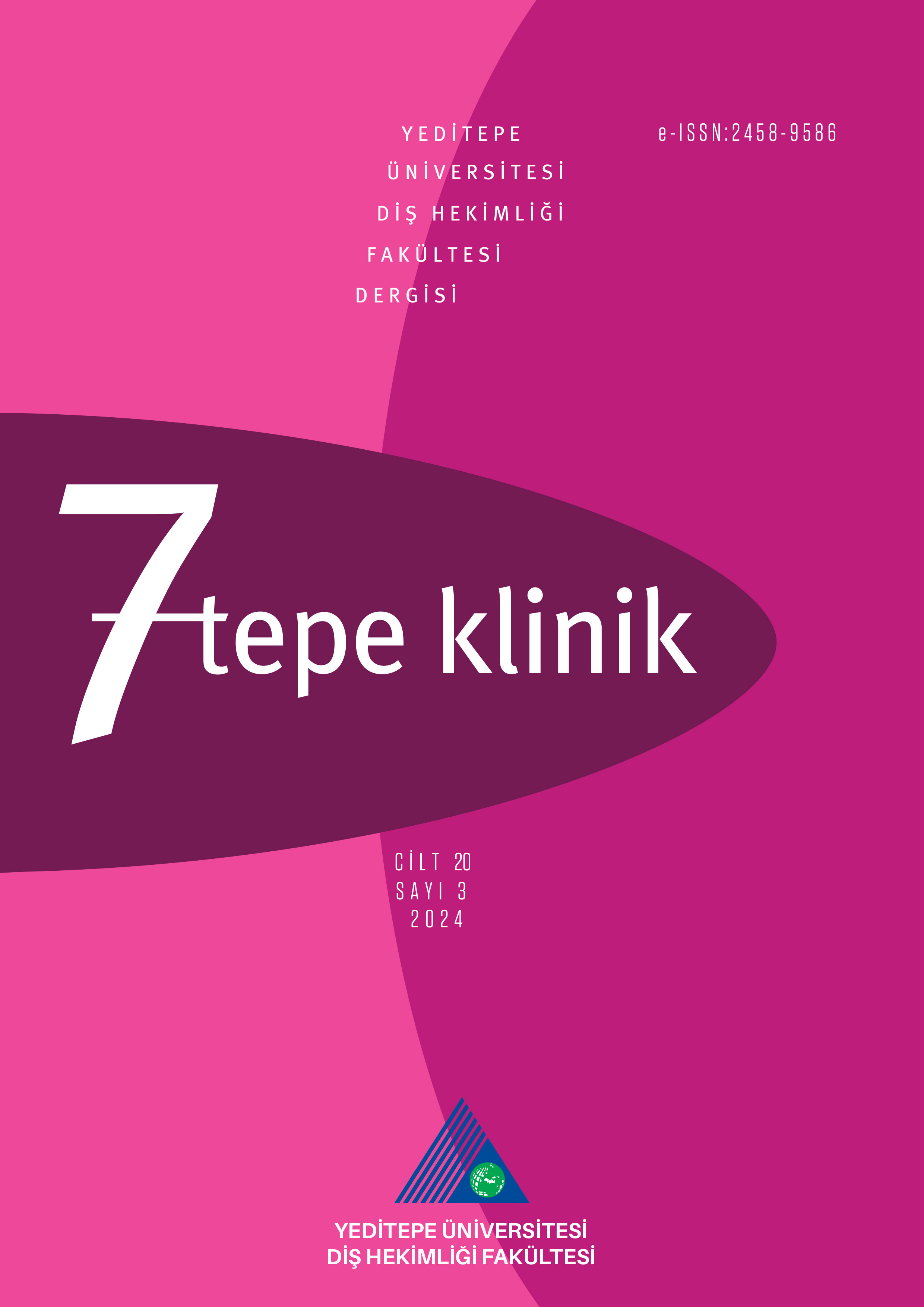Agresif periodontitisin mikrobiyal ı̇çeriği ve cerrahi olmayan periodontal tedavisi: İki olgu sunumu
Dilek Mamaklıoğlu1, Bahar Eren Kuru2, Maribasappa Karched3, Başak Doğan41İstanbul Aydın Üniversitesi Diş Hekimliği Fakültesi, Periodontoloji Ana Bilim Dalı, İstanbul2Yeditepe Üniversitesi Diş Hekimliği Fakültesi, Periodontoloji Ana Bilim Dalı, İstanbul
3Kuveyt Üniversitesi, Biyoklinik Bilimler Ana Bilim Dalı, Kuveyt
4Marmara Üniversitesi Diş Hekimliği Fakültesi, Periodontoloji Ana Bilim Dalı, İstanbul
Bu olgu raporunun amacı iki generalize agresif periodontitis (GAgP) hastasının subgingival mikrobiyolojik profilini belirlemek ve cerrahi olmayan periodontal tedavinin (COPT) 6 aylık klinik sonuçlarını sunmaktır. Kliniğimize başvuran iki GAgP hastasının havuzlama yöntemiyle toplanan subgingival örnekleri, 300 tür/filotipin varlığını belirlemek için Human Oral Microbiome Identificaition Microarray analizi kullanılarak incelendi. COPT 3 hafta içinde uygulandı. Klinik parametreler tedavi öncesi, sonrası 3. ve 6. aylarda kaydedildi. Hastalar, ilk 3 ayda 2 haftada bir, son 3 ayda 4 haftada bir kontrol seanslarına çağırıldı. Tüm örneklerde toplam 61 türe ve iki hastada ortak 32 türe rastlandı. İlk hastada 17, diğer hastada 12 farklı tür tespit edildi. İki hastada da yüksek seviyede Filifactor alocis, Porpyromonas gingivalis, Campylobacter concisus and rectus, Fusobacterium nucleatum and Desulfobulbus spp. saptanırken Aggregatibacter actinomycetemcomitans tespit edilmedi. COPT sonrası altıncı ayda A. actinomycetemcomitans-negatif iki GAgP hastasının tüm klinik parametrelerinde iyileşme olduğu gözlendi. Bilinen periodontal patojenlere ek olarak yüksek seviyedeki Filifactor alocis ve Desulfobulbus spp.nin varlığının GAgP ile ilişkilendirilebileceği düşünülmüştür.
Anahtar Kelimeler: Agresif periodontitis, periodontal tedavi, mikrobiyal genetik, oligonü, kleotid mikroarrayMicrobial composition and non-surgical periodontal treatment of aggressive periodontitis: Two case report
Dilek Mamaklıoğlu1, Bahar Eren Kuru2, Maribasappa Karched3, Başak Doğan41Istanbul Aydın University, Faculty of Dentistry, Department of Periodontology, Istanbul, Turkey2Yeditepe University, Faculty of Dentistry, Department of Periodontology, Istanbul, Turkey
3Kuwait University, Department of Bioclinical Sciences, Kuwait
4Marmara University, Faculty of Dentistry, Department of Periodontology, Istanbul, Turke
The objective of this case report was to characterize the subgingival microbiological profiles of two patients with generalized aggressive periodontitis (GAgP) and to evaluate the clinical outcomes of non-surgical periodontal treatment (NSPT) over a 6-months period. Pooled subgingival samples of two patients who referred to our clinic and diagnosed with GAgP were collected and analyzed for the presence of 300 species/phlotypes using Human Oral Microbe Identification Microarray analysis. NSPT was performed within 3-week period. Clinical parameters were measured at baseline, 3 and 6 months after NSPT. Recall visits were performed every 2 weeks during the first 3 months and every 4 weeks up to 6 months. All samples harboured a total of 61 species and 32 species were common in both patients. First patient had 17 and the other had 12 distinct species. High levels of Filifactor alocis, Porpyromonas gingivalis, Campylobacter concisus and rectus, Fusobacterium nucleatum and Desulfobulbus spp. were detected in both patients while Aggregatibacter actinomycetemcomitans was found in none of them. Six months after NSPT, all clinical parameters were improved in two A. actinomycetemcomitans-negative GAgP patients. In addition to well-recognized periodontal pathogens the presence of high levels of Filifactor alocis and Desulfobulbus spp. seem to be associated with GAgP.
Keywords: Aggressive periodontitis, periodontal treatment, microbial genetics, oligonucleotide microarraysMakale Dili: İngilizce



